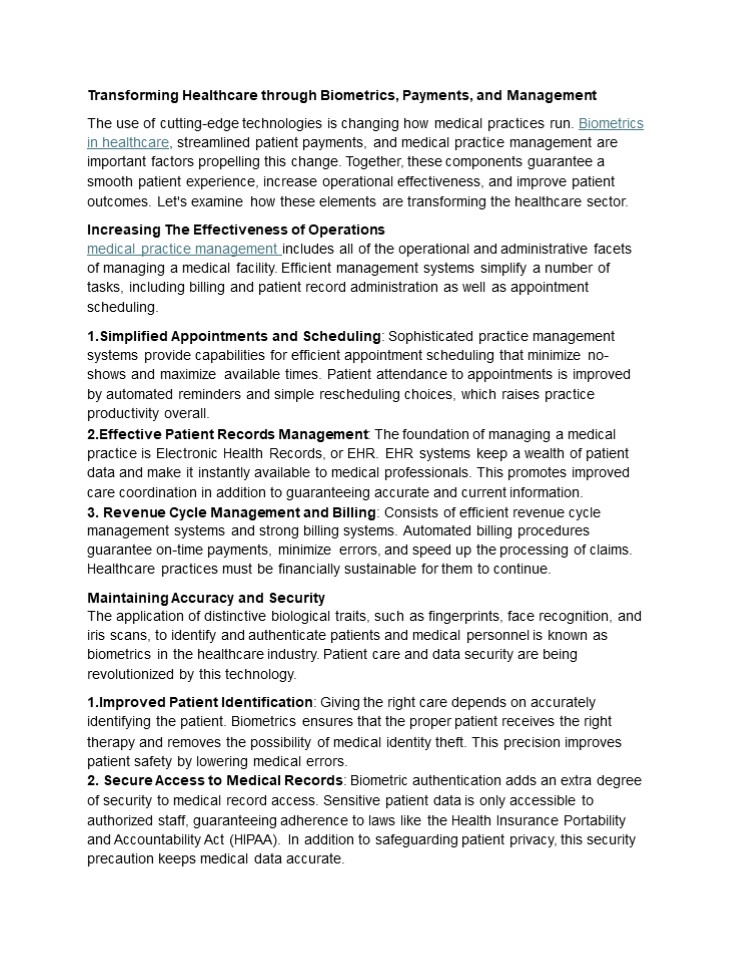Transforming Healthcare through Biometrics, Payments, and Management PowerPoint PPT Presentation
Title: Transforming Healthcare through Biometrics, Payments, and Management
1
- Transforming Healthcare through Biometrics,
Payments, and Management - The use of cutting-edge technologies is changing
how medical practices run. Biometrics in
healthcare, streamlined patient payments, and
medical practice management are important
factors propelling this change. Together, these
components guarantee a smooth patient
experience, increase operational effectiveness,
and improve patient - outcomes. Let's examine how these elements are
transforming the healthcare sector. - Increasing The Effectiveness of Operations
- medical practice management includes all of the
operational and administrative facets of
managing a medical facility. Efficient management
systems simplify a number of - tasks, including billing and patient record
administration as well as appointment
scheduling. - Simplified Appointments and Scheduling
Sophisticated practice management systems
provide capabilities for efficient appointment
scheduling that minimize no- shows and maximize
available times. Patient attendance to
appointments is improved by automated reminders
and simple rescheduling choices, which raises
practice productivity overall. - Effective Patient Records Management The
foundation of managing a medical practice is
Electronic Health Records, or EHR. EHR systems
keep a wealth of patient - data and make it instantly available to medical
professionals. This promotes improved care
coordination in addition to guaranteeing accurate
and current information. - Revenue Cycle Management and Billing Consists of
efficient revenue cycle - management systems and strong billing systems.
Automated billing procedures guarantee on-time
payments, minimize errors, and speed up the
processing of claims. Healthcare practices must
be financially sustainable for them to continue. - Maintaining Accuracy and Security
- The application of distinctive biological traits,
such as fingerprints, face recognition, and iris
scans, to identify and authenticate patients and
medical personnel is known as biometrics in the
healthcare industry. Patient care and data
security are being revolutionized by this
technology. - Improved Patient Identification Giving the right
care depends on accurately identifying the
patient. Biometrics ensures that the proper
patient receives the right - therapy and removes the possibility of medical
identity theft. This precision improves patient
safety by lowering medical errors. - Secure Access to Medical Records Biometric
authentication adds an extra degree - of security to medical record access. Sensitive
patient data is only accessible to - authorized staff, guaranteeing adherence to laws
like the Health Insurance Portability - and Accountability Act (HIPAA). In addition to
safeguarding patient privacy, this security
precaution keeps medical data accurate.
2
- 3. Streamlined Check-In Procedures The patient
check-in procedure is accelerated by biometric
technology. Quick identity verification for
patients reduces wait times and enhances their
entire experience. This effectiveness is
especially advantageous in busy healthcare
settings, where time is of the essence. - Financial Transaction Simplification
- Medical practices' financial stability is largely
dependent on having effective patient payment
mechanisms. Not only does streamlining the
payment process boost cash flow, but it also
makes the patient experience better. - Flexible Payment Options By providing a variety
of payment methods, such as digital wallets,
credit cards, and electronic fund transfers,
healthcare providers may accommodate the wide
range of patient preferences. Patients' financial
burdens are lessened with flexible payment
plans, such as installment choices, which
increases patient accessibility to healthcare. - Transparent Billing Practices that are
unambiguous and transparent in billing foster - patient trust. Clear explanations of prices and
itemized information help to minimize
misunderstandings and disagreements. This
openness promotes on-time payments and increases
patient satisfaction. - Automated Payment technologies These
technologies boost productivity and - lessen the workload for administrative staff.
Patients may effortlessly manage their payments
with features like online payment gateways and
automated payment reminders. This automation
lowers the possibility of past-due bills and
guarantees steady cash flow. - Using Technology to Promote Holistic Development
- Healthcare is becoming more comprehensive because
to the interaction of biometrics, medical
practice management, and effective patient
payments. These technologies work together to
produce a secure, effective, and seamless
healthcare environment. - Better Patient Experience The patient experience
is improved by streamlined operations, precise
patient identification, and easier payment
procedures taken - together. Reduced wait times, safe information
management, and easy financial transactions are
all advantageous to patients. - Improved Operational Efficiency Increased
operational efficiency is advantageous - to healthcare providers. Healthcare workers can
concentrate more on patient care when there is
less administrative work to do thanks to
automated technologies. The practice operates
efficiently when appointments, documentation, and
billing are managed - effectively.
- Better Patient Outcomes More precise
identification and efficient processes help to
improve patient outcomes. Healthcare
professionals can give timely and appropriate
3
care when they have access to dependable patient
data and well-functioning processes. This
accuracy lowers mistakes, raises patient safety,
and boosts general health results. Conclusion The
healthcare sector is changing because of the
combination of medical practice management,
biometrics in healthcare, and effective patient
payments. In the end, these technologies improve
patient experiences and outcomes by increasing
operational efficiency, ensuring security and
accuracy, and streamlining financial transactions.

